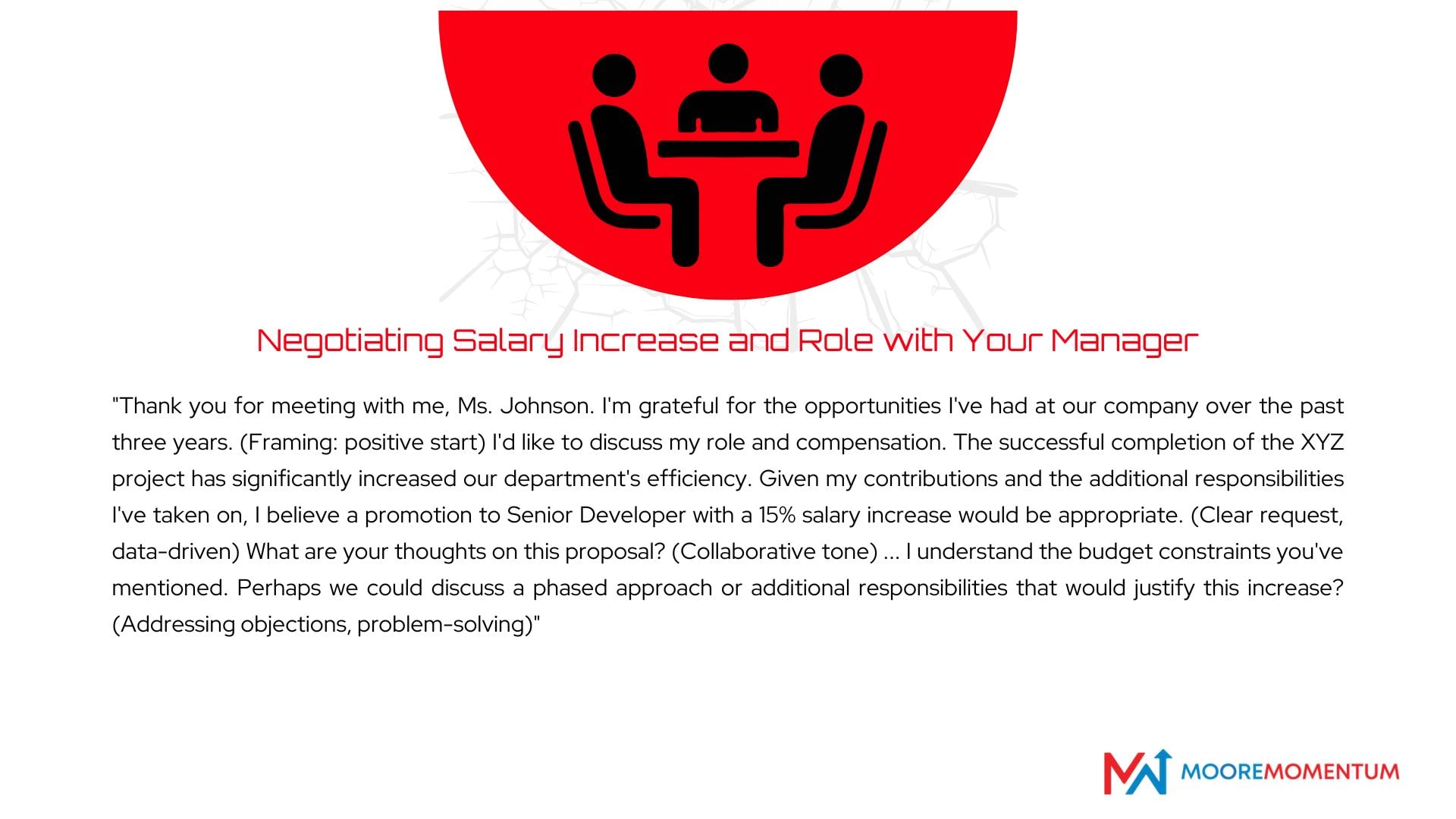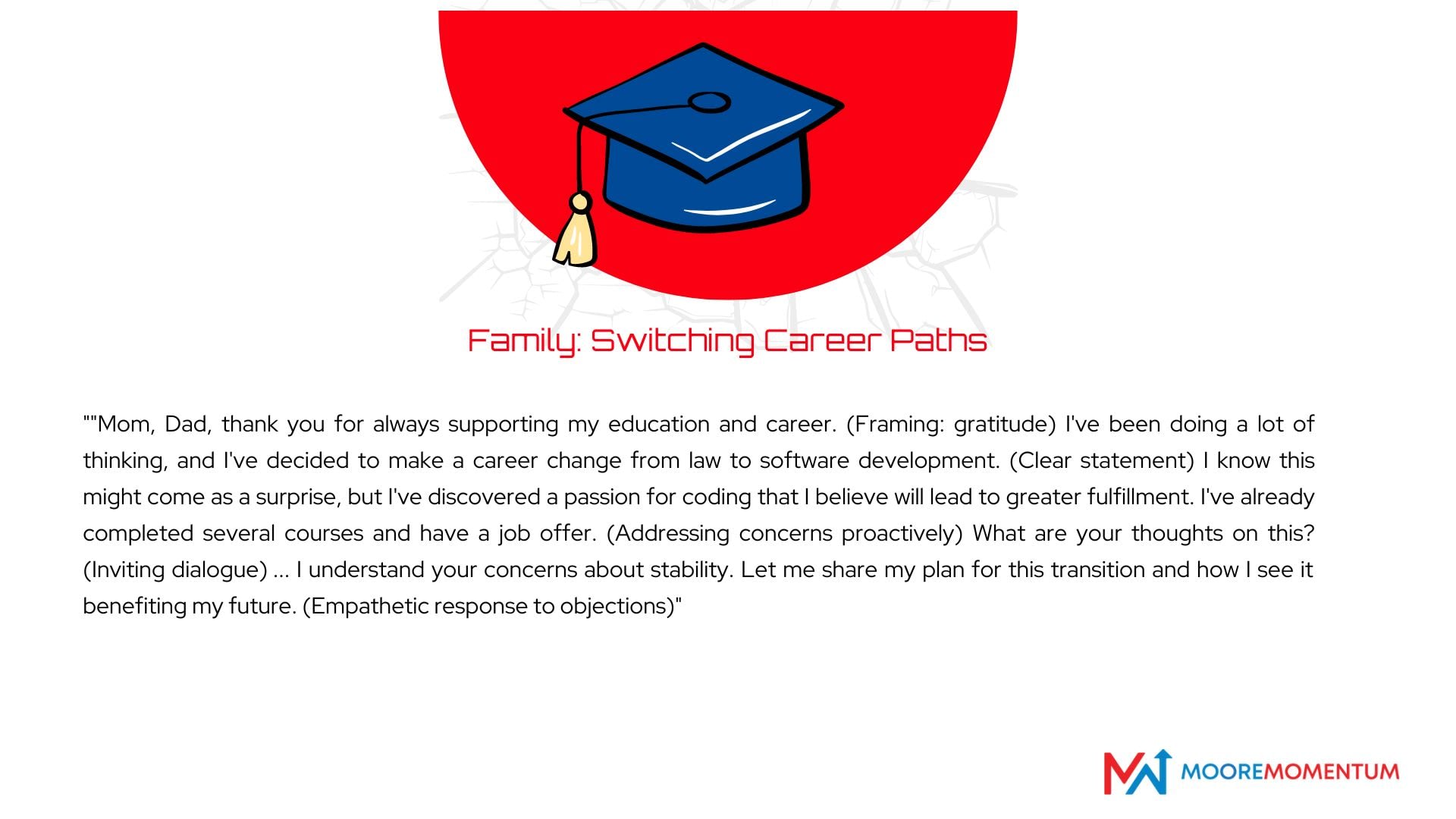
How to Have Difficult Conversations with the Help of AI
Feb 21, 2025
By Will Moore
With the amount of difficult conversations we're forced to have in today's world, you may wonder why the question of handling a hard conversation isn't taught as a basic subject in school.
Whether it's clarifying a misunderstanding with a friend, having a hard conversation with a colleague about their performance, or you need to discuss a sensitive issue with a family member, crucial conversations are a daily part of life.
What if there was a way to prepare for these important conversations that combined the best of behavioral science and modern technology to achieve much better results?
Enter the world of artificial intelligence (AI), a powerful tool that provides effective techniques for ensuring that tough conversations transform into productive conversations that build trust, resolve conflict, and improve the overall quality of relationships.
Upgrades You'll Receive From This Blog:
A cutting-edge AI-assisted approach to prepare for and navigate challenging conversations
Practical strategies to manage emotions, understand different perspectives and find constructive solutions
Customizable AI prompt templates for common difficult conversation scenarios
Techniques to transform challenging dialogues into opportunities for growth and better understanding
A comprehensive guide to enhance your communication skills and build confidence in tackling tough talks
By leveraging AI as a preparatory tool, you can transform these difficult moments into opportunities for growth, improved communication skills, and improved relationships. Let's embark on this journey to enhance your communication skills, problem solve, and build the confidence to tackle even the most challenging dialogues head-on.
Understanding and Navigating Difficult Conversations
Difficult conversations are those interactions that challenge us emotionally and intellectually. They often involve conflicting perceptions, interpretations of events, and strong feelings. These dialogues can range from addressing performance issues at work to discussing relationship problems with a partner or confronting a friend about their behavior.
The importance of handling difficult conversations cannot be overstated. When we avoid tough convos, we risk:
Allowing problems to fester and grow
More resentment and damaging relationships
Missing opportunities for personal and professional growth
Hindering effective problem-solving within teams or families
Why do I struggle to have difficult conversations?
Despite their importance, many people shy away from these hard conversations. Common reasons include:
Fear of conflict or confrontation
Concern about hurting someone’s feelings
Lack of confidence in communication skills
Uncertainty about the outcome
Desire to maintain harmony at all costs
However, learning to navigate these discussions skillfully is crucial for building strong relationships, fostering a positive work environment, and achieving personal growth. By developing the right mindset and tools, we can transform these tough conversations into opportunities for positive change.
Core Components of Difficult Conversation
One key aspect of mastering difficult conversations is recognizing that they typically involve three core components:
The “What Happened?” Conversation: This focuses on facts and interpretations.
The Feelings Conversation: This addresses the emotions involved for all parties.
The Identity Conversation: This relates to what the situation means to each person’s self-image.
Understanding these components can help us approach difficult moments with greater clarity and empathy. It allows us to separate facts from emotions and to consider how the conversation might impact each person’s sense of self.
What are the 4 D's of difficult conversations?
The Four D’s of difficult conversations refer to common patterns or pitfalls that can make discussions more challenging. They are:
Denial – Avoiding or dismissing the issue instead of addressing it head-on. This can lead to unresolved conflicts and resentment.
Defensiveness – Reacting protectively or aggressively instead of listening. This can shut down open communication and escalate tension.
Disengagement – Withdrawing from the conversation, either emotionally or physically, to avoid discomfort. This prevents resolution and can harm relationships.
Domination – Trying to control the conversation or overpower the other person instead of working toward a mutual understanding. This can make the other party feel unheard or dismissed.
Recognizing these tendencies can help keep conversations constructive and focused on resolution rather than conflict.
What are the 3 C's to difficult conversations?
The Three C’s of difficult conversations are:
Clarity – Be clear about your message, what you want to communicate, and what outcome you're aiming for. Avoid ambiguity and ensure the other person understands your perspective.
Compassion – Approach the conversation with empathy. Acknowledge the other person's feelings and perspectives, and show that you care about their well-being, even if the discussion is tough.
Curiosity – Stay open-minded and ask questions to understand the other person’s viewpoint. Instead of making assumptions, listen actively and seek to learn from the conversation.
These three principles help navigate difficult discussions while maintaining respect and fostering productive dialogue.
Read More: How to be a better listener in a relationship
The AI-Assisted Approach To Difficult Conversations: A Comprehensive Guide
Artificial Intelligence (AI) can be a powerful ally in preparing for challenging conversations. By leveraging AI tools, we can gain new insights, organize our thoughts, and develop effective strategies for these important dialogues.
Recognizing one's own contributions in tough talks is crucial to encouraging understanding and maintaining a balanced sense of self.
Here’s how to use an AI-assisted approach:
Pre-Conversation: AI-Assisted Preparation
Enter a prompt into AI that includes the following elements:
Goal of the conversation: Brief description of what you hope to get from it from both sides).
Background/Details: Including:
Your take on the situation (What happened) and how this is affecting you emotionally.
Your understanding of their perspective/potential objections (including emotions they may have).
Framing: Sandwich the difficult part between two positives.
Positive opening: Start with a positive statement that affirms the relationship or shared goals
Addressing the difficult issue: Present your talking points clearly and respectfully
Positive closing: End with a forward-looking statement that emphasizes collaboration
Key Strategies: Keep in mind the following I'll want to use when applicable during the conversation [Cut paste the "key strategies" from below].
Tone: Be empathetic to their point of view and come from the perspective of "same team" instead of "me vs you" or "my way or the highway."
Ask: "Please provide a brief talking points outline of key talking points based on all above provided information."
Prepare For Various Scenarios
Upon receiving your desired response (tweak above if necessary), ask the AI to identify potential emotional and ego-related triggers and prepare for different outcomes. Choose the following scenarios that apply:
Emotional Escalation: The conversation becomes heated, with rising anger or frustration
Defensiveness: The other party becomes defensive, refusing to engage constructively
Unexpected Reactions: The other party responds in a way you didn't anticipate
Power Imbalances: Feeling intimidated or powerless in the conversation
Conversation Derailment: The discussion veers off-topic or into unproductive territory
Impasse: Reaching a deadlock with no apparent way forward.
Choose the Right Time and Place
Select a private, neutral location
Ensure enough uninterrupted time
Consider the other person's schedule and energy levels
Key Strategies For Managing Difficult Conversations:
Establishing clear ground rules within a difficult conversation helps maintain respect, structure, and a productive outcome. Here are essential guidelines to follow:
1. Set a Positive, Collaborative Tone
Begin the conversation with your AI-prepared opening talking point
Use a calm, non-confrontational, “team-oriented” tone
Tackle difficult dialogues by addressing challenging discussions to improve understanding and relationships
2. Active Listening
Focus on understanding, not just responding
Use non-verbal cues to show engagement
Paraphrase to confirm understanding
3. Use “I” Statements
Share how the situation impacts you personally
Start with phrases like “I’ve noticed…” or “I’m concerned about…”
Express feelings without blaming
Connect feelings to needs. I.e. “I feel frustrated when…” instead of “You always…”
4. Emotional Intelligence
Recognize and manage your own emotions
Be attuned to the other person’s emotional state
Consider how the conversation might affect both parties’ sense of identity.
Maintain a growth mindset and view the discussion as a learning opportunity
5. Summarize and Plan Next Steps
Recap key points of agreement to ensure mutual understanding
Outline decisions or actions to be taken
Set a time for follow-up if necessary
By writing out and engaging with these AI-generated insights, as well as reviewing the key strategies before starting a hard conversation, you will:
Develop a more comprehensive and empathetic perspective.
Practice self-reflection and accountability. Read our detailed blog on Self Reflection Questions for Growth
Prepare for various possible reactions
Transform challenging conversations into opportunities for growth and better understanding.
Remember, the AI-assisted method’s goal is not to script the entire conversation but to enter it with a clear mind, balanced viewpoint, and readiness to listen and engage constructively.
Difficult Conversations Examples
Let's explore three common scenarios and how to use the above difficult conversation training guide to handle each effectively.
How to Have Difficult Conversations in Relationships?
Navigating difficult conversations in relationships requires empathy, active listening, and clear communication. Whether discussing unmet expectations, resolving conflicts, or setting boundaries, here’s how to approach it:
Create a Safe Space – Choose the right time and place to talk, ensuring privacy and minimal distractions.
Use “I” Statements – Express feelings without blaming. Instead of “You never listen,” try “I feel unheard when my concerns aren’t acknowledged.”
Practice Active Listening – Reflect back what the other person is saying before responding.
Stay Open to Resolution – Approach the conversation as a problem-solving session rather than a battle to win.
Use AI for Role-Playing – AI tools can help you practice difficult discussions by simulating different responses and emotional reactions.
Example - Personal: Breaking Up with a Partner
AI Prompt Template:
Goal: "I need to break up with my partner. The goal of this difficult conversation is to [Your goals, e.g., end the relationship amicably, ensure mutual understanding]."
Background: "Here's some background info on the situation [provide relevant details about your relationship]. Also, here is:
My perspective: [Your reasons for wanting to end the relationship]
Their perspective: [Your understanding of your partner's view of the relationship, related emotions, and potential objections to breaking up]
Framing: "Help me structure this conversation to sandwich the difficult news between positive statements about our time together and my care for them."
Key Strategies: "Keep in mind the following key strategies I'll want to use during the actual conversation" [Cut paste the "key strategies" from above]
Tone: "Guide me on maintaining an empathetic tone and approaching this from a 'same team' perspective rather than 'me vs. you.'
Ask: "Please provide a brief talking points outline of key talking points based on all above provided information."
After receiving the AI's response, ask it to:
. "Identify potential emotional and ego-related triggers in the conversation."
"Give me a few practice responses for the following scenarios" [choose the most relevant from above "Prepare For Various Scenarios" Info]:
Emotional Escalation: The conversation becomes heated, with rising anger or frustration.
Unexpected Reactions: The other person responds in a way I didn't anticipate.
Impasse: Reaching a deadlock with no apparent way forward.

How to Have Difficult Conversations as a Manager?
Managers often face challenging conversations about performance, promotions, and workplace behavior. To navigate these talks effectively:
Set Clear Expectations – Ensure employees understand their roles and responsibilities.
Use Data-Backed Feedback – Instead of vague statements, provide specific examples.
Manage Emotional Reactions – Stay composed and de-escalate tensions if needed.
Guide, Don’t Dictate – Encourage employees to propose solutions rather than imposing them.
Leverage AI for Coaching and Scenario Planning – AI can predict likely reactions and help you prepare appropriate responses
Example - Professional: Negotiating Salary Increase and Role with Your Manager
AI Prompt Template:
Goal: "I'm preparing to negotiate a salary increase and role change with my manager. The goal of this difficult conversation is to [Your goals, e.g., secure a specific salary increase, change in role]."
Background: "Here's some background info on the situation [provide relevant details]. Also, here is:
My perspective: [Your achievements and contributions to the company]
Their perspective: [Your understanding of your boss' and the company's position and potential objections]."
Framing: "Help me structure this conversation to sandwich my request between positive statements about the company and my commitment."
Key Strategies: "Keep in mind the following key strategies I'll want to use during the actual conversation" [Cut paste the "key strategies" from above]
Tone: "Guide me on maintaining a professional yet collaborative tone, emphasizing a 'same team' approach."
Ask: "Please provide 4-5 key talking points based on this information."
After receiving the AI's response, ask it to:
"Identify potential emotional and ego-related triggers in the conversation."
Defensiveness: The other person becomes defensive, refusing to engage constructively
Power Imbalance: Feeling intimidated or powerless in the conversation

How to Have Difficult Conversations with Family?
Family conversations can be emotionally charged, whether discussing personal choices, boundaries, or long-standing issues. Here’s how to make them more productive:
Choose the Right Moment – Timing matters. Don’t start a heavy conversation during a stressful family event.
Set Emotional Boundaries – Keep emotions in check and avoid being reactive.
Listen Before Responding – Acknowledge their point of view before offering your perspective.
Clarify Your Intentions – Let them know you’re having the conversation to improve relationships, not to criticize.
Use AI for Emotional Intelligence Training – AI tools can help practice responses to emotionally triggering statements.
Impasse: Reaching a deadlock with no apparent way forward
Scenario - Family: Switching Career Paths
AI Prompt Template:
Goal: "I need to tell my family I'm changing my career path. The goal of this difficult conversation is to [Your goals, e.g., gain family support, explain my decision clearly]."
Background: "Here's some background info on the situation [provide relevant details about your current and planned career]. Also, here is:
My perspective: [Your reasons for changing careers and your plan]
Their perspective: [Your understanding of your family's expectations and potential concerns]
Framing: "Help me structure this conversation to sandwich the news of my career change between expressions of gratitude and future optimism."
Key Strategies: "Keep in mind the following key strategies I'll want to use during the actual conversation" [Cut paste the "key strategies" from above]
Tone: "Guide me on maintaining an appreciative and confident tone while addressing their potential concerns empathetically."
Ask: "Please provide 4-5 key talking points based on this information."
After receiving the AI's response, ask it to:
"Identify potential emotional and ego-related triggers in the conversation."
"Give me a few practice responses for the following scenarios" [choose the most relevant from above "Prepare For Various Scenarios" Info]:
Defensiveness: Family members become defensive about their previous advice or expectations
Conversation Derailment: The discussion veers off-topic or into unproductive territory
Unexpected Reactions: Family members respond in a way you didn't anticipate
Remember, while AI assists in the preparation, genuine empathy, and active listening are crucial for successfully navigating these difficult moments. Use these templates to prepare thoroughly, but remain flexible and responsive during the actual conversations.
For all scenarios, conclude by summarizing key points, re-emphasizing the positive aspects, and planning the next steps.

Power-Ups You've Gained From This Blog
Congratulations! You've now equipped yourself with powerful tools to navigate difficult conversations more effectively:
AI-Assisted Conversation Preparation: A cutting-edge approach to prepare for challenging conversations using AI.
Emotion Management Strategies: Techniques to manage emotions during tough dialogues.
Customizable AI Prompt Templates: Versatile templates for common difficult conversation scenarios.
Conflict-to-Growth Mindset: Transform challenging dialogues into opportunities for growth and leveling up in life.
Enhanced Communication Skills: Boost your confidence to tackle even the toughest talks.
Take Your Skills to the Next Level with Moore Momentum
Ready to transform your communication skills and achieve breakthrough results in all areas of your life? Experience Moore Momentum – a comprehensive personal development system that amplifies these principles across all five core areas of life: Mindset, Relationships, Health, Wealth, and Personal Growth.
With Moore Momentum, you'll access advanced AI-powered tools, engage in immersive role-play scenarios, and receive personalized coaching to overcome your unique communication challenges.
Don't let this be just another blog post you read and forget. Take action now and turn these insights into lasting change.
Click Here to Learn More About the Moore Momentum System and Transform Your Life
Start your journey to mastering difficult conversations and unlocking your full potential today!
FAQs - Navigating Difficult Conversations
How to Have Difficult Conversations with Clients?
Managing expectations and resolving disputes with clients requires a professional, solutions-focused approach:
Acknowledge Their Perspective – Show clients you understand their concerns before offering solutions.
Be Transparent About Issues – If delays or mistakes happen, own up to them while providing a clear action plan.
Focus on Mutual Benefit – Shift the conversation towards how both parties can move forward.
Stay Professional and Emotionally Neutral – Avoid reacting defensively, even if the client is upset.
Use AI for Pre-Call Preparation – AI can help structure responses to common client objections, ensuring a smoother conversation.
How to Have Difficult Conversations with Employees?
As a leader, providing constructive feedback and handling tough conversations with employees is essential for growth and performance improvement. Here’s how to do it effectively:
Prepare Your Message – Clearly define the issue and the outcome you want.
Frame it Constructively – Focus on solutions rather than criticism. Example: “I’d love to see more attention to detail in your reports” instead of “Your work is sloppy.”
Be Direct but Empathetic – Balance honesty with kindness.
Encourage Two-Way Dialogue – Allow the employee to share their perspective and concerns.
Use AI for Coaching – AI can generate talking points, helping you frame difficult feedback in a constructive way.
How to Have a Difficult Conversation with Someone You Love?
Pick the Right Moment – Choose a calm, private setting.
Be Clear and Kind – Start with care: “I want to talk because I value our relationship.”
Use “I” Statements – Say, “I feel…” instead of “You never…” to avoid blame.
Listen Fully – Let them speak without interrupting.
Stay Calm – Manage emotions, and take a pause if needed.
Focus on Solutions – Ask, “How can we move forward together?”
Reaffirm Your Love – End with reassurance: “I care about you, and this matters to me.”
Approach with respect, and you’ll build trust while addressing the issue.
